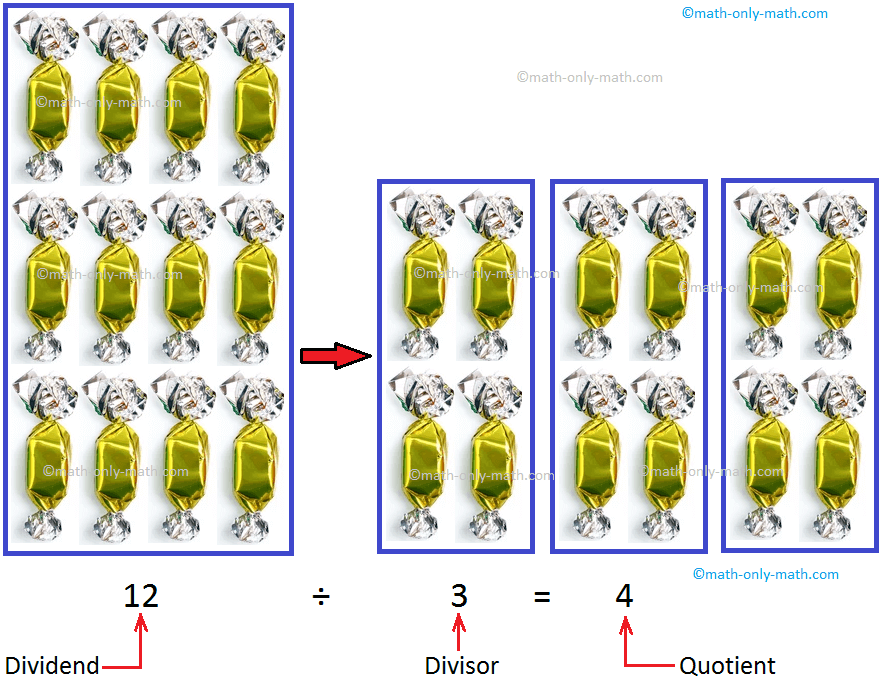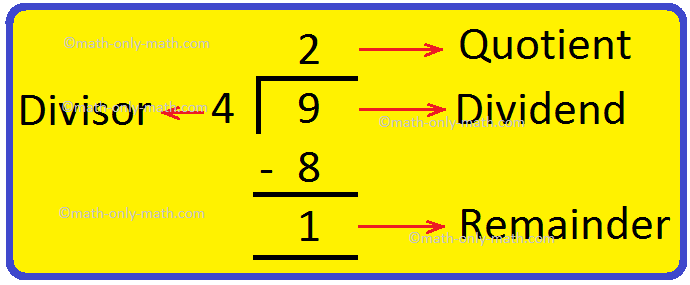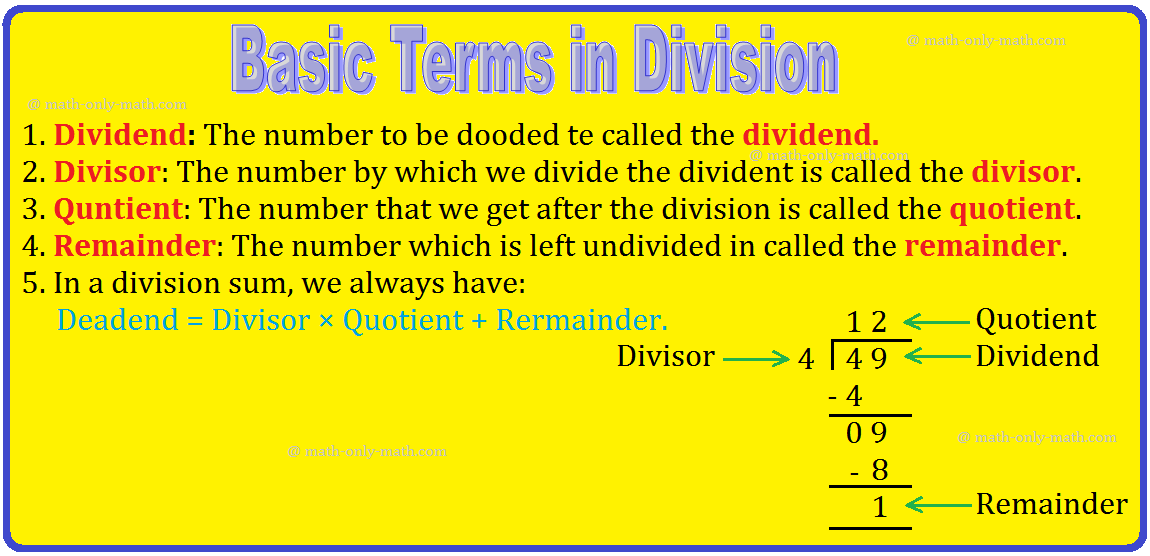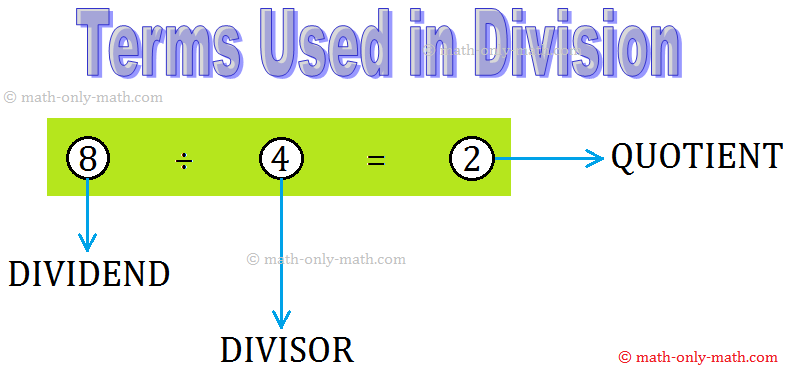Subscribe to our ▶️ YouTube channel 🔴 for the latest videos, updates, and tips.
Terms Used in Division
The terms used in division are dividend, divisor, quotient and remainder.
We know that divisor means to split a large group of objects into smaller equal groups. The larger group is called the dividend. The number of smaller equal groups is called the divisor and the number of objects in each smaller group is called the quotient.
Let us divide 12 candies among 3 children.
Now, let us divide 9 flowers into 2 equal groups.
When we cannot make equal groups or share equally all the objects, the number which is left undivided is called the remainder. Remainder is always less than the divisor.
Division is repeated subtraction.
For example:
24 ÷ 6
How many times would you subtract 6 from 24 to reach 0?
24 - 6 = 18 one time
18 - 6 = 12 two times
12 - 6 = 6 three times
6 - 6 = 0 four times
For every multiplication fact, there are two division facts.
For example:
(i) 5 × 7 = 35
35 ÷ 5 = 7; 35 ÷ 7 = 5
(ii) 8 × 6 = 48
48 ÷ 8 = 6; 48 ÷ 6 = 8
(iii) 9 × 5 = 45 is the same as 45 ÷ 9 = 5
7 × 9 = 63 is the same as 63 ÷ 7 = 9
Each of the terms used in division are explained below:
The number which is divided is called the dividend.
The number which divides is called the divisor.
The number which is the result of the division is called the quotient.
If there is any number left over, it is called the remainder.
The answer of a division operation can be verified in the following manner:
Quotient × Divisor + Remainder = Dividend
Consider the following examples to understand the terms showing in the division:
(i) 54 divided by 6
Dividend = Divisor × Quotient + Remainder
54 = 6 × 9 + 0
(ii) 81 divided by 9.
Dividend = Divisor × Quotient + Remainder
81 = 9 × 9 + 0
Properties of Division:
Let us recall the properties of division:
I: When the dividend is 0 and the divisor is a non-zero number, the quotient is 0.
(i) 0 ÷ 9 = 0
(ii) 0 ÷ 45 = 0
(iii) 0 ÷ 4524 = 0
II. When the divisor is 1, the quotient is the same number as the dividend.
(i) 8 ÷ 1 = 8
(ii) 77 ÷ 1 = 77
(iii) 4254 ÷ 1 = 4254
III. When the dividend and the divisor are the same non-zero number, the quotient is 1.
(i) 7 ÷ 7 = 1
(ii) 16 ÷ 16 = 1
(iii) 250 ÷ 250 = 1
SUMMERY
Terms Related to Division
In a division sum,
1. The number which is to be divided is called the dividend.
2. The number by which we divide is called the divisor.
3. The answer of division is called the quotient.
The above terms are interrelated as follows:
Dividend = Divisor × Quotient
The above relation is used to check the correctness of division problems.
The number being divided is called the dividend, the number dividing it is called the divisor and the result is called the quotient.
There is another way of showing this division.
This is called the long division method.
Worksheet on Terms Used in Division:
1. Now, complete the following table. One has been done for you:
|
Equation |
Dividend |
Divisor |
Quotient | |
|
(i) |
9 2)\(\overline{1 8}\) |
18 |
2 |
9 |
|
(ii) |
6 3)\(\overline{1 8}\) |
_____ |
_____ |
_____ |
|
(iii) |
3 5)\(\overline{1 5}\) |
_____ |
_____ |
_____ |
|
(iv) |
5 4)\(\overline{2 0}\) |
_____ |
_____ |
_____ |
|
(v) |
2 9)\(\overline{1 8}\) |
_____ |
_____ |
_____ |
Answer:
1. (ii) Dividend: 18; Divisor: 3; Quotient: 6
(iii) Dividend: 15; Divisor: 5; Quotient: 3
(iv) Dividend: 20; Divisor: 4; Quotient: 5
(v) Dividend: 18; Divisor: 9; Quotient: 2
2. Match the columns: Terms Used in Division
|
Quotient |
Question |
Remainder | |
|
(i) |
6 |
4|\(\overline{36}\) |
1 |
|
(ii) |
5 |
8|\(\overline{65}\) |
3 |
|
(iii) |
9 |
7|\(\overline{45}\) |
4 |
|
(iv) |
4 |
6|\(\overline{26}\) |
0 |
|
(v) |
8 |
9|\(\overline{49}\) |
2 |
Answer:
2. (i) 6 → 7|\(\overline{45}\) → 3
(ii) 5 → 9|\(\overline{49}\) → 4
(iii) 9 → 4|\(\overline{36}\) → 0
(iv) 4 → 6|\(\overline{26}\) → 2
(v) 8 → 8|\(\overline{65}\) → 1
3. Fill in the blanks:
(i) 15 ÷ 1 = _____
(ii) 21 ÷ _____ = 21
(iii) 12 ÷ _____ = 1
(iv) 0 ÷ 7 = _____
(v) 7 ÷ 1 = _____
(vi) 0 ÷ 20 = _____
(vii) 18 ÷ 18 = _____
(viii) 9 ÷ 0 = _____
(ix) 42 ÷ 42 = _____
Answer:
3. (i) 15
(ii) 1
(iii) 12
(iv) 0
(v) 7
(vi) 0
(vii) 1
(viii) undefined / meaningless
(ix) 1
1. What are the terms in division for class 4?
1. What are the terms in division for class 4?
Answer:
In the division sum,
• The number to be divided is called the dividend.
• The number with which we divide is called the divisor.
• The answer we get after division is called the quotient.
In a division sum, we write these term as:
Quotient
Divisor ) Dividend
Related Concept
● Addition
● Check for Subtraction and Addition
● Word Problems Involving Addition and Subtraction
● Estimating Sums and Differences
● Multiply a Number by a 2-Digit Number
● Multiplication of a Number by a 3-Digit Number
● Word Problems on Multiplication
● Division of Two-Digit by a One-Digit Numbers
● Division of Four-Digit by a One-Digit Numbers
● Division by 10 and 100 and 1000
● Division by Two-Digit Numbers
From Terms Used in Division to HOME PAGE
Didn't find what you were looking for? Or want to know more information about Math Only Math. Use this Google Search to find what you need.










New! Comments
Have your say about what you just read! Leave me a comment in the box below. Ask a Question or Answer a Question.